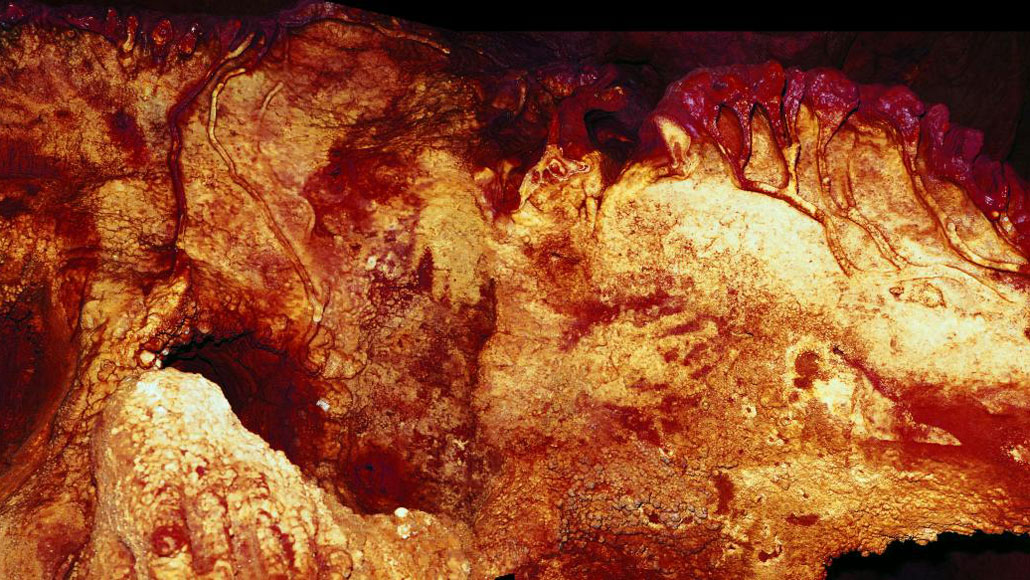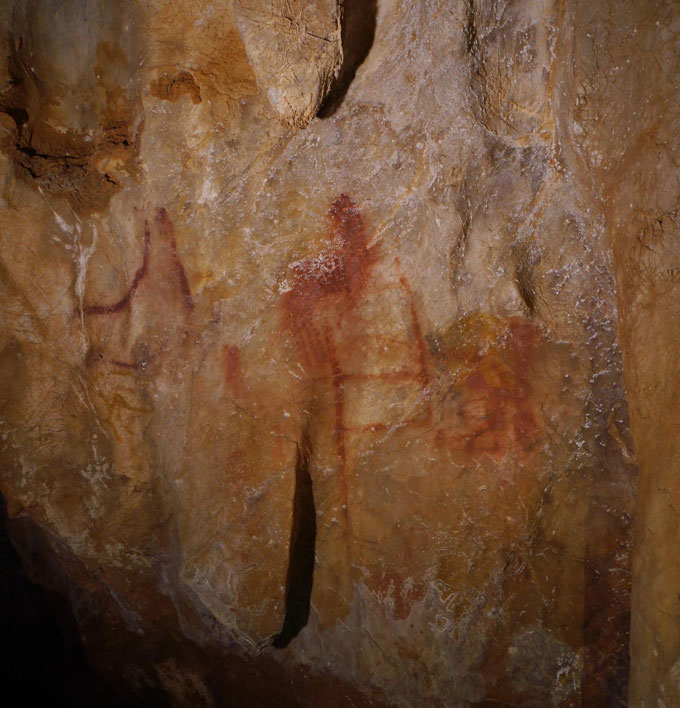
Spanish cave paintings, including these hand stencils (center), may not date to Neandertal times due to complications with a technique for dating mineral deposits, researchers argue. But the claim is controversial.
H. Collado
Ancient European cave paintings recently attributed to Neandertals have ignited an ongoing controversy over the actual age of those designs and, as a result, who made them.
The latest volley in this debate, published October 21 in the Journal of Human Evolution, contends that rock art in three Spanish caves that had been dated to at least roughly 65,000 years ago may actually be tens of thousands of years younger. If so, then Stone Age humans could have created the painted symbols and hand outlines (SN: 2/22/18). Neandertals died out by around 40,000 years ago (SN: 6/26/19).
An international group of 44 researchers, led by archaeologist Randall White of New York University, concludes that the controversial age estimates, derived from uranium-thorium dating, must be independently confirmed by other dating techniques. Those approaches include radiocarbon dating and thermoluminescence dating, which estimates the time since sediment was last exposed to sunlight.
Until that occurs, “there is still no convincing archaeological evidence that Neandertals created [southwestern European] cave art,” the scientists contend. “This is probably the first time 44 cave art researchers have agreed on anything,” White says.
The team that dated the Spanish paintings, led by geochronologist Dirk Hoffmann of the Max Planck Institute for Evolutionary Anthropology in Leipzig, Germany, stands by its original analysis and will submit a response to the latest critique of its findings to the Journal of Human Evolution.
Critics of the age estimates had suggested previously that Hoffmann and his team had mistakenly dated cave deposits unrelated to the Spanish rock art, resulting in excessive age estimates. Now, the latest chapter of this debate revolves around the reliability of uranium-thorium, or U-Th, dating. Hoffmann’s group analyzed thin mineral deposits partly covering painted areas to calculate minimum ages for the art, based on estimates of the rate at which radioactive uranium in the deposits decayed into radioactive thorium.

But water running across cave surfaces and leaching into rock can reduce uranium in mineral deposits, making it appear that uranium has been decaying longer than it actually has, White’s group says. In that case, U-Th dates for the rock art would be misleadingly old, the researchers argue.
Leaching may have contributed to a minimum U-Th age of about 65,000 years that Hoffmann’s group found for the left side of a rectangular figure in Spain’s La Pasiega cave, the Neandertal art critics suggest. The other side of that same figure received a U-Th date of about 3,100 years. A difference of around 60,000 years in minimum age estimates for the same drawing raises concerns about the accuracy of those calculations, especially a surprisingly ancient age estimate, White’s group says. Similar rectangular cave paintings have been radiocarbon-dated to about 15,440 years ago at Spain’s Altamira Cave and to roughly 13,940 years ago in a cave located on the same hillside as La Pasiega, the team adds.
Comparably large differences in U-Th age estimates also characterized mineral deposits topping hand stencils attributed to Neandertals by Hoffmann and his colleagues at another Spanish cave, White’s group asserts. Elsewhere in Europe and Indonesia, hand stencils on cave walls have been dated to no more than around 40,000 years ago and generally attributed to humans.
These criticisms of cave art ages don’t hold up, responds archaeologist Paul Pettitt of Durham University in England, a member of Hoffmann’s team. He emphasizes that several layers of rock deposits covering each cave painting were dated separately. Age estimates became progressively older moving from the outermost, youngest layers to the innermost, oldest layers situated closest to the art. That’s a good indication that water did not leach into the rock and lower uranium levels, he says.
Varying rates of sediment formation can result in some U-Th ages differing substantially from others, even for the same cave painting, Pettitt says. But minimum ages for the innermost, oldest sediment layers, he and his colleagues argue, are closest to the age of the art underneath.
The outcome of this dating debate will have big implications for understanding the cultural and mental lives of ancient humans and Neandertals. “The overwhelming majority of cave art remains undated,” Pettitt says.
Accepting that Spanish cave art dates back to when Neandertals inhabited western Europe would raise new questions about symbolic traditions in Stone Age cultures, he says. For instance, did the possibly Neandertal-era rectangular figure in La Pasiega cave influence later, Homo sapiens-era rectangular designs in other European caves? “We cannot conclude that we have a representative understanding of the origins and development of art, cave or otherwise.”







